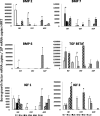Induction of bone formation in abdominal implants constituted by collagen sponges embedded with plant-based human transforming growth factor family proteins in ectopic dog model
- PMID: 26914756
- PMCID: PMC4648846
- DOI: 10.1186/s40634-014-0011-z
Induction of bone formation in abdominal implants constituted by collagen sponges embedded with plant-based human transforming growth factor family proteins in ectopic dog model
Abstract
Background: Trauma, osteomyelitis, bone tumour resections and congenital deformities are the main causes of bone deficiency in which autologous graft is the preferred treatment, but usually the bone supplies are limited.
Methods: An experimental model of heterotopic bone formation in the subcutaneous abdominal area of dogs was developed. This model consists in omentum wrapped implants constituted by collagen type 1 sponges embedded with demineralized bone powder, calcium cloride, thrombin and platelet rich plasma; the implant is totally converted in trabecular bone after four months of implantation. This model was improved by accelerating bone production, after the isolation of the most conspicuous histological constituents (inflammatory, bone and adipose tissues) by laser microdisection and purified from them RNA that was used to determine by RT-PCR the gene expression kinetics of the most important growth bone factors. Then, the most abundant and rapidly synthesized factors were produced by genetic engineering in tobacco plants.
Results: Bone morphogenetic proteins 2 and 7 and transforming growth factor-β1were the most rapidly and highly synthesized factors, and they were efficiently produced in a genetic engineering plant based system in tobacco leaves. Their incorporation as recombinant proteins in the scaffold collagen sponge induced in just one month mature heterotopic bone.
Conclusion: This study demonstrates for the first time that this plant system is able to produce recombinant bone growth factors in high amount and at low cost, and they were highly efficient to rapidly induce bone formation in abdominal implants potentially useful for autotransplantation.
Keywords: Bone morphogenetic proteins; Heterotopic bone; Tissue engineering.
Figures




References
-
- Obert L, Deschaseaux F, Garbuio P. Critical analysis and efficacy of BMPs in long bones non-union. Injury Int J Care Injured. 2005;365:538–542. - PubMed
-
- Giotakis N, Narayan B, Nayagam S. Distraction osteogenesis and nonunion of the docking site: is there an ideal treatment option? Injury 38: S100e7. 2007. - PubMed
-
- Ekelund A, Brosjo¨ O, Nilsson O. Experimental induction of heterotopic bone. Clin Orthop. 1991;263:102–12. - PubMed
LinkOut - more resources
Full Text Sources
Other Literature Sources

